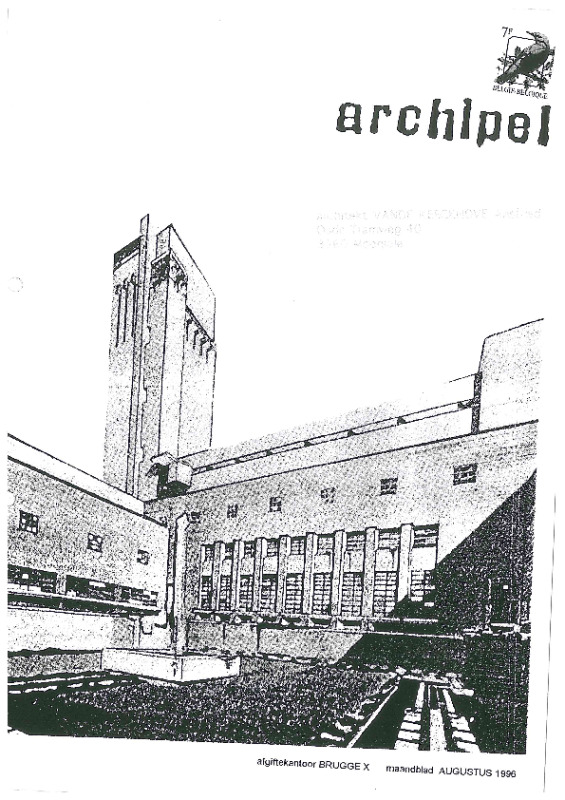Dudok in Hilversum
No city in the Netherlands is so clearly shaped by the hand of one architect Hilversum. In 1915 Willem Marinus Dudok was appointed Director of Public Works. In more than five decades, he built schools, public buildings, villas and residential areas. His masterpiece was completed in 1931: the town hall of Hilversum. One of the most prominent buildings in interwar Europe. The building became an icon of modern architecture in the Netherlands and Belgium inspiring worked for many architects of that time.
Following a large demonstration in Hilversum Dudok established, we lay archipelago with a bus. In the recently restored hall is an exhibition on the life and work of Dudok visited. The exhibition ‘Dudok, composer of architecture’ shows next to drawings, models and photographs, including computer animation and a light and sound show. Naturally, the town hall is visited under expert supervision. Afterwards set aside ample time for a cycle route that takes us along through Hilversum Dudok various projects.
nabeschouwing
ARCHIPEL BY BIKE … DUDOK AND DUIKER IN HILVERSUM
Our architecture tours and trips we have tested nearly all means of transport. Ordinary buses, double-deckers, mini-buses, trains, TGVs, subways, airplanes, carferrys, ferries, also like the original private motorboat in Como, or demanding: as the hikes in Berlin. The bike we had not had. It appeared in Hilversum on September 7 the ideal formula to visit architecture. Divided into ten small groups, a process of DUDOK buildings was scattered cycled across the city.
The (600 million BF) thoroughly restored town hall (1924-1931) is one of those monuments of architectural history at the frontier of modernity and tradition that one must have seen. Photos are utterly irrelevant. One has to be there, and to move around there. Similar to work at Wright in Chicago, it has a very complex, functionally and geometrically arranged plan and a loaded ingenious composition of spaces, volumes, surfaces and lines, based on spatial and visual delight. The architectural thinking has been extended from the urban integration, on architectural compositions craftsmanship in materials and detailing … down to the smallest detail chair or lamp. Every object, foreign to Dudok, here is unbearable and was therefore carefully kept out of the building during the restoration. Although the hard restoration has erased all patina, but still remains a captivating visit to the wars.
The bike tour through Hilversum, we saw a fairly representative (but obviously limited) series of buildings of Dudok, who has put an incredible body of work in Hilversum. In order of the route: The Multatuli School (1930), the Northern Cemetery (1940-45) (a very serene white entrance-building, akin to the work of JP Oud), the Van Hichtum School (1929), Snell School (with its striking cylindrical stairwell of glass blocks), the third communal housing (1919-20) (inspired by rural villas). In between J. hotel-restaurant Gooiland Diver (1934-36), built shortly after the town hall by Dudok. We see in this building Diver, breaking the radical modernism in a bright elegant concrete structure with glass curtain walls. Rembrandt School (1919-20) (influenced by the Amsterdam School), Fabritius School (1926) – Ruysdael School (1928), a rural building with romantic thatched roof), Juliana School (1925), fifth communal housing (1920), Geranium School (1916-18 ) cemetery Zuiderhof (1964) (one of the last works of Dudok with a U-shaped strand colonna the Data building as a hard, unattached access to a cemetery-park). Bavinckschool (1920-21) (forerunner of the town hall with a similar compositional treatment of volumes). Finally, the bathhouse (1920-21) (also related to the town hall, but by its symmetry rather a ponderous mausoleum). In the great exhibition ‘Dudok, composer of architecture’ the link between this work was completed.
The surprising end this interwar day was a visit to the Sunbeam-sanatorium JP Diver. The complex was built simultaneously with the town hall and there is an incredible architectural contrast that we hardly thought possible. Resolute revolutionary, avant-garde modernist, elegant, light, transparent … and his time, unfortunately, building physics too far ahead. Where the main parts of the (since the victory over the TBC, become useless sanatorium), somewhat were maintained, the pavilion wings cut in an untold state of decaying carcass. A hallucinatory archaeological ruins of concrete rot, twisted steel, ripped facades, broken piece of glass. Bouwfysisch decline, helped by vandalism.
There seems unusual for this ‘contemporary’ complex restoration imminent. We hope so. The Sunbeam complex testifies to the possession of Diver to shift radically the architecture boundaries in his time. An elegant design which was performed experimentally naive and hopeless in the field of building technology.
A fascinating contrast with the approach of Dudok in the town hall, which swore by building tradition. Ostensibly, the town hall is structurally less naive, but this was only an illusion. The lack of expansion joints, bricked rainwater drains and use of poor stone, survived the hall just after the recent heavy restoration that almost borders on reconstruction. (The tower is new. All windows and two-thirds of the walls are new.)
Marc Felix
Programme
- 08u00 achterzijde station, Brugge
- 08u30 Holiday Inn, Gent – afrit UZ
- 11u.00 bezoek raadshuis en tentoonstelling Dudok
- middagmaal: gezien korte tijdsbestek, vragen wij u een pick-nick mee te brengen
- 13u.00-17u.00: fietsroute 15 km langsheen de voornaamste Dudok-gebouwen in Hilversum. Een achttal scholen, een badhuis, een hotel en een aantal woonwijken. Dudok heeft in Hilversum bijna 2.000 gebouwen gerealiseerd. De fietsroute geeft hiervan een vrij representatief beeld.
- 18u.00 terugtocht
- 21u.00 Gent
- 21u.30 Brugge

